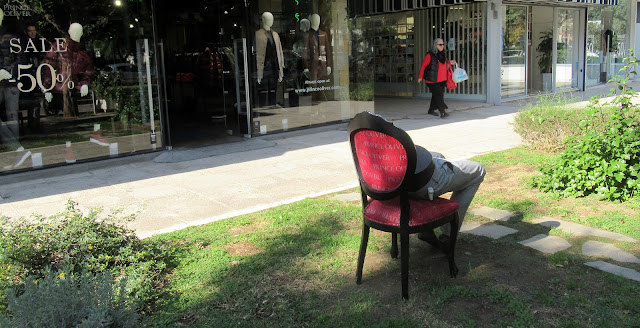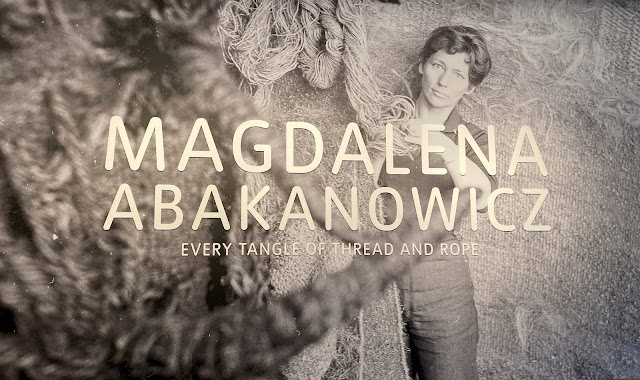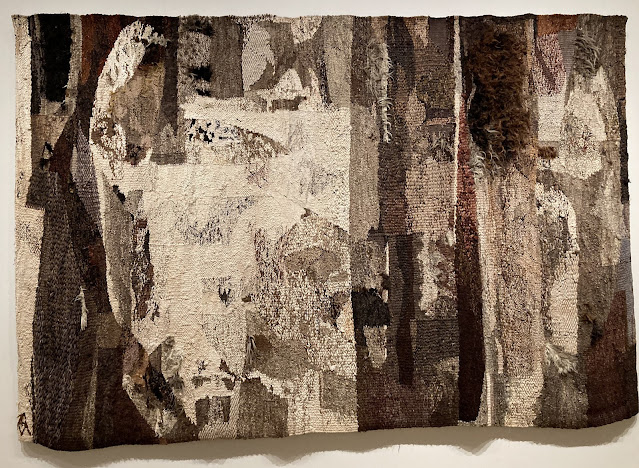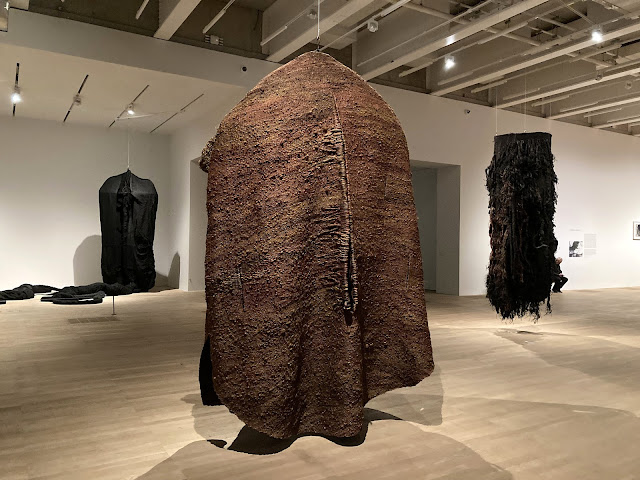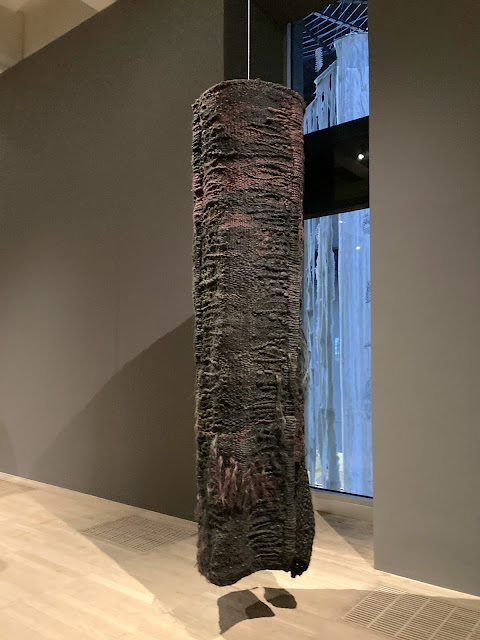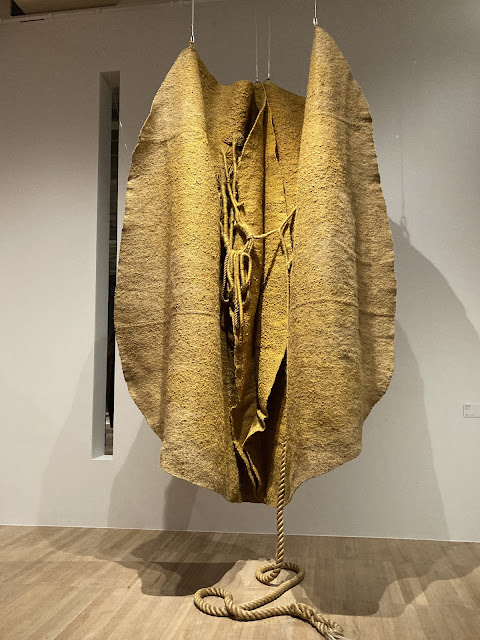We saw this exhibition before we left for Greece. One of the best I have seen in a long time.
Magdalena Abalakawicz - Every Tangle of Thread and Rope
In the 1960s and 70s Polish artist Magdalena Abakanowicz created large woven sculptures that became known as Abakans (after the artist's surname). These ambiguous forms made from thread and rope defied categorisation and challenged the existing definitions of sculpture.
This exhibition surveys a transformative period of the artist's early career when her weavings came off the wall into three-dimensional space. Abakanowicz first emerged as a leader of the New Tapestry movement of late 1960s Europe. Artists associated with the movement began to claim fibre as a valid medium for the creation of art. To this end, Abakanowicz saw importance in being recognised as a sculptor by major art galleries and museums. She exhibited internationally, bringing her monumental, fibrous forms into new relationships or 'situations' within the gallery - paving the way for the installation art of today. Her environmental attitudes, such as her wish to work and live in harmony with nature, feel particularly timely today.
Wall weavings:
Censorhip and restrictions of the arts in Poland enforced by the Soviet regime seemed to ease in the initial mid-1950s post-Stalinist thaw and trans-media experimentation flourished. Opportunities for 'craft' or 'folk art' were particularly well-supported through the state-sponsored Association of Polish Artists, of which Abakanowicz was a member. Although she experimented with pieces created for interior design and with painting on fabric, she was more interested in the expressive potential of weaving.
Abakanowicz started producing large, experimental works. Her improvisatory style of weaving without a 'cartoon' (template) shocked the critics. Her works carry the differing influences of Polish avant-garde developments in formal art (concerned with matter) and constructivism (concerned with spatial and geometric concepts).
Green Composition, 1956-57, (gouache on cotton canvas)
Abakanowicz's early education in painting alongside weaving resulted in this piece and the one below. Hanging freely, unstretched and unframed, they begin to test the spatial possibilities of textile. They were both included in Abakanowiez's first solo exhibition. The Polish authorities closed the show before it opened to the public, declaring it to be 'too formalistic' and not actively engaged with the building of socialism.
Composition, 1960, (gouache on linen)
looking closer
Desdemona, 1965, (wool fleece, sisal, cotton, artificial silk and horsehair)
Helena, 1964-65, (wool, cotton, sisal and horsehair)
looking closer
Tapisserie 21 Brune, 1963 (wool)
Sun, 1963, (wool, cotton and artificial silk)
Textural Composition White, 1961-2, (sisal and cotton)
Untitled, 1965, (ink and gouache on papers on paper)
Untitled, 1965, (ink and gouache on papers on paper)
Untitled, 1965, (ink and gouache on papers on paper)
In the second gallery, featuring work from the mid-1960s we see textiles that broke with the rectangular format of traditional tapestry, confronting the viewer with curved forms hanging freely in space. They are woven with sisal (the fibre from a flowering plant) sometimes incorporating wool and horsehair.
She said: 'I see fibre as the basic element constructing the organic world on our planet... It is from fibre that all living organisms are built, the tissue of plants, leaves and ourselves... our nerves, our genetic code, the canals of our veins, our muscles... We are fibrous structures'.
Black, 1966, (sisal, rope and horsehair)
Diptere, 1967, (hemp, sisal and horsehair)
At times, Abakanowicz titled her works in French. Here, the word diptere refers to the English Diptera, an order of insects that use one pair of wings to fly. This includes, most commonly, the fly.
Assemblage Noir, 1966, (sisal, wool, hemp and horsehair)
Pregnant, 1970-80, (sisal and horsehair)
side view
Three-dimensional work (including A Fibrous Forest):
Baffled by the ambiguity of Abakanowicz's work, in 1964 an art critic first coined the term 'Abakans' after the artist's surname. Abakanowicz later adopted this term to refer to her large three-dimensional works, which she presented in dense arrangements. When installing an exhibition she determined their placement, often clustering works together in dialogue with each other and the surrounding gallery space. She referred to her installations as 'situations' and later as 'environments' into which she introduced found elements alongside her hand-woven forms.
The works presented in the third gallery are grouped together to echo some of her own installations. They also recall her interest in the forest's ability to provide shelter. 'The Abakans were my escape from categories in art, they could not be classified. Larger than me, they were safe like the hollow trunk of the old willow I could enter as a child in search of hidden secrets'.
A stunning display in this gallery that literally took my breath away. This display includes two of Abakanowicz's first fully three-dimensional forms, and the Fibrous Forest, an installation of eleven forms. She said of them: 'The fabric I made was stiff, its surface grew into reliefs similar to tree bark or animal fur'.

Unknown artist, Papua New Guinea, Middle Sepik, Blackwater region, Didagur - Female Initiation Mask, 1970s, (plant fibre, clay, cassowary feathers).
This mask was displayed alongside Abakanowicz's works, clearly an inspiration for her own work.
In 1976, Abkanowicz travelled to Papua New Guinea to visit its rainforests and journey by canoe on the Sepik River. She was especially moved by the art of the various Sepik people, which she understood to be 'an expression of people's interaction with their physical and supernatural environment'. A year later, she received this mask as a gift from a friend who accompanied her. Made in the Blackwater region it would have been used in ritual initiation dances.

Abakan Etroit, 1967-69, (sisal and wool)
Abakan - Situation Variable II, 1971, (sisal and rope)
a different view
part of A Fibrous Forest
part of A Fibrous Forest
looking closer
part of A Fibrous Forest
part of A Fibrous Forest
part of A Fibrous Forest
part of A Fibrous Forest
part of A Fibrous Forest
Petrified Organism is a total 'situation' devised by the artist, combining a pair of giant garment-like, hanging forms that have been created from industrially woven cloth and ropes that spill out onto the floor. The hollow 'garments' evoke a protective shell or coat, while the entwined fibres of rope suggest the complexities of the nervous system or interstines.
Abkanowic had begun to use the sisal from ropes to weave her works when other materials were less readily available. She explains how she sourced local maerials and prepared them at home in Warsaw: 'Along the Vistula River one could find old, discarded ropes. They had their own history. They became my material. I pulled out thread, washed and dyed them on our gas stove'.
Rope later became an important element of her forms and 'environments'. She would occasionally use it to lead the viewer between spaces or even to connect different buildings within a city. As she stated, 'the rope to me is like a petrified organism, like a muscle devoid of activity. Moving it, changing its position and arrangement, touching, I can learn its secrets and multitude of its meanings., It carries its own story within itself, it contributes this to it surroundings'.
Invented Anatomy:
In 1978 Abakanowicz began a new series of ambiguous forms titled Embryology, made from a combination of fabrics and fibres bundled and bound into rounded, organic masses. 800 of these forms were originally shown together at the Venice Biennale in 1980. Referring to Embryology, she explained: 'the contents, the inside, the interior of soft matter fascinated me... By 'soft', I mean organic, alive. What is organic, What makes it alive? In which region of throbbing begins the individuality of matter, its independent existence? ... They were completing my physical need to create bellies, organs, an invented anatomy. Finally, a soft landscape of countless pieces related to each other'.

Abakan January - February, 1972, (sisal)
Abakan Orange, 1971, (sisal)
Embryology, 1978-81, (burlap, cotton gauze, hemp rope, nylon and sisal)
Abakan Red, 1969, (sisal)
Abakan Orange, (sisal)
Other works:
The final room in the exhibition was a photographic record of some of Abakanowicz's other work - with the exception of one sculpture.
In the late 1980s to 1990s she began to use metals such as bronze for her sculptures, as well as wood, stone and clay.
Anasta, 1989, (wood and steel)
Anasta is part of Abakanowicz's series War Games which she created between 1987 and 1995. The works are made from felled trees found in the Masurian Lake District, Poland. She wrote: 'I looked at these huge bodies, muscular, wounded, but full of strength and personality: trunks with amputated limbs, in gestures of pain or protest or helplessness'. Viewed as bodily forms she wrapped them in burlap and metal cladding. Like the name of the cycle implies, these sculptures have a very militaristic feel to them, as they have been compared to artilery vehicles. The series title War Games indicates her later exploration of humanity's capacity for violence and destruction.


Abakanowicz's final round of work includes a project called Agora, which is a permanent installation located at the southern end of Chicago's Grant Park. It consists of 106 cast iron figures, each about nine feet tall. All the figures are similar in shape but different in details. The artist and her three assistants created models for each figure by hand, and the casting took place from 2004 to 2006. The surface of each figure resembles a tree bark or wrinkled skin. The work creates a feeling of crowdedness, hence the name Agora. Furthermore, the bodies end at the torso, giving them an anonymous look.
'We live in times which are extraordinary because of their various forms of aggression. Today new danger exists around us as if everyone were against everyone. Agora should become a symbol, a metaphor about this particular historical moment in which we need each other, in which we want to relly on each other more than ever'.
Katarsis, 1985 (bronze)
At the Spazi d'Arte sculpture park, Italy. 33 standing figures.
Negev, 1987, (seven ten-ton wheels created by stonemasons)
At the Billy Rose Sculpture Garden, Jerusalem. Abakanowicz is impressed by the local limestone field with fossils. Negev is a response to the barren desert, the silence of its rocks, and the prehistoric shores of the Mediterranean. At the same time, its round forms resemble wheels or milestones.

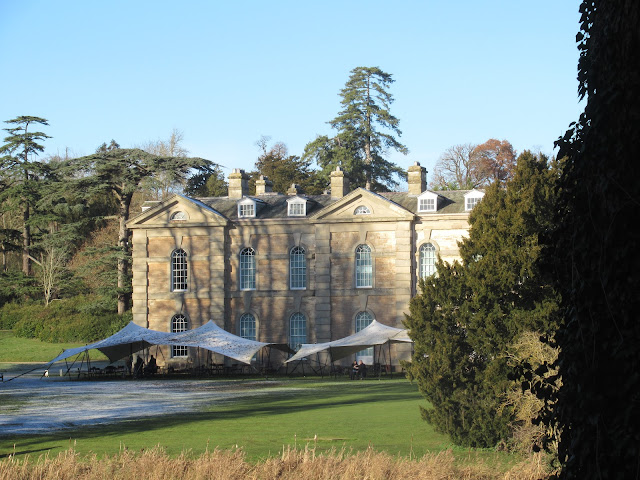

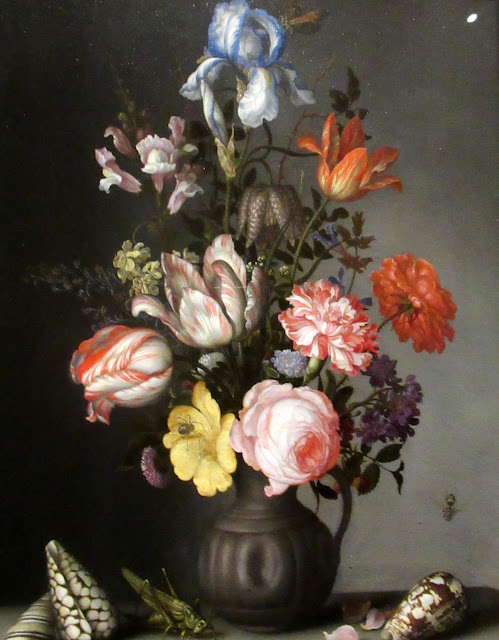
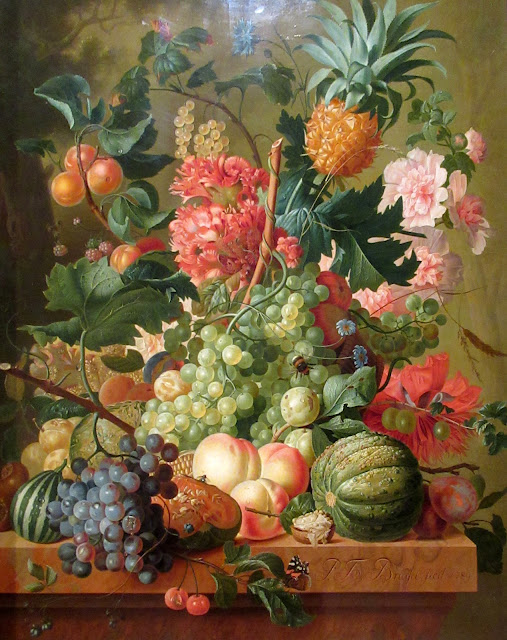


.JPG)
.JPG)







